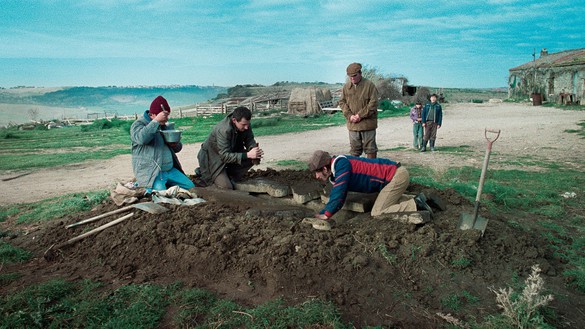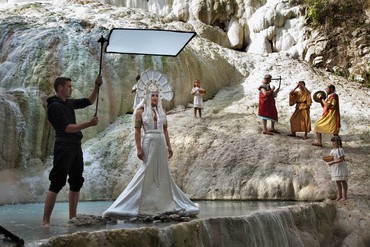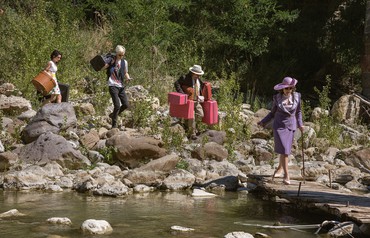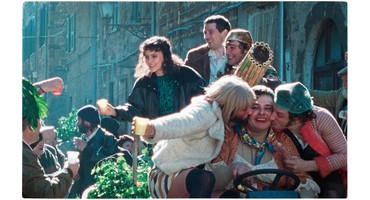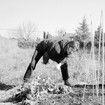
Mike Stinavage is a writer and waste specialist from Michigan. During his political science masters program at CUNY Graduate Center, he was awarded Fulbright and Martin Kriesberg fellowships to research the politics of waste in Northern Spain. He currently coordinates a European project on biowaste policy and writes fiction in Pamplona, Spain.
When the young sisters and their beekeeper father walk up the stream to a grotto, a kind of amphitheater formed from a flow of white rock, there, standing in front of a film crew, is what looks like an Etruscan goddess in white. Between takes of an announcement for an artisanal-goods competition, this woman—played by Monica Bellucci—addresses the children, long white hair draping down from a towering headdress. She hands them a flyer, inviting them to take part in the competition.
The Wonders (2014) was the enchanting first film in a triptych written and directed by Alice Rohrwacher. In 2018, Happy as Lazzaro, equally as enchanting if not more so, followed. This year the triptych reaches its third and final film, La Chimera.
On a Saturday-morning video call, Rohrwacher speaks congenially. The walls and space behind her are white and unassuming, and overhead are ceilings of exposed timber—she is presumably on the top floor of her home. She’s quick to smile. From the outset of the conversation, Rohrwacher speaks in a mixture of Italian and English, the gaps between her English and my Italian filled by artist and impromptu interpreter Clara Gargano.
It’s been a big year for Rohrwacher and her collaborators. A few big years, in fact. In 2021, alongside codirectors Francesco Munzi and Pietro Marcello, Rohrwacher presented Futura, an interview-based documentary that asks young Italians from disparate regions and backgrounds to contemplate the future. Earlier this year, Rohrwacher’s short Le Pupille (The pupils) took her to the United States when it was nominated for an Oscar. And in May, La Chimera premiered at the Cannes Film Festival and competed, as the triptych’s first two films had in their time, for the Palme d’Or.
With Catholicism, the lesser-known Italy of the Etruscans, and rural life as the triptych’s recurring muses, Rohrwacher poses a central question: what should be done with the past? In each film she directs this question to the local area where the three Italian regions of Umbria, Tuscany, and Lazio meet.
It’s a part of Italy that I really love because it’s not clear where it’s going. It’s not yet eaten by the tourism, but at the same time it is in danger because of course there are a lot of tourists. Here there is also a big attempt by agro-industry to acquire this land and devastate it. This region is very fragile but very beautiful. It has the potential to evolve in other ways as well, not only based on the consumption of the land or the culture.
Rohrwacher calls this border region home.
The area once held Etruscan relics and artifacts below the surface. Now, they are much harder to come by.
Films now always try to draw the viewer inside; instead, I like to keep the viewer outside to contemplate the world.
Alice Rohrwacher
La Chimera is Rohrwacher’s tribute to archaeology, which, given the film’s grave-robbing and site-destroying protagonists, may not be readily apparent. During the 1980s and ’90s, men went after the ancient artifacts buried in this region with shovels, pickaxes, and any other tool necessary.
I was little, and I was . . . very scared of them. Almost every man looked for treasure. There was a treasure-hunt fever. I was very impressed because they did it against the law, against the sun law, the law of the living; but also against the night law, the law of the dead and of the past. I was very impressed because I always wondered how they found the authority to do it, to open ancient tombs that for 3,000 years nobody had opened. And suddenly they were saying, “Ok, I’ll open it.” They brought everything to America, to Switzerland, to everywhere. It was the first generation that felt profoundly separated from its own past. And so I was interested in this aspect: to tell the story of a group of new men who are different, who are detached from their past.
At the center of La Chimera is Arthur, a foreign—non-Italian—and romantic man who is part of the gang but unsatisfied by the exhumed plunder alone. The film balances the gravity of romance and tragedy with the burlesque and the ironic.
I tried to keep these elements together which, in my opinion, are always very difficult to keep together. It is easier to abandon yourself entirely to the tragic-romantic vein or to make a film that is truly a comedy. Instead, I tried to keep these two aspects together, a bit like saying, “I really believe that they are part of the contradiction of existence: being able to have an ironic look but still being able to draw a lesson from the tragedy.”
Rohrwacher’s films are as down to earth as they are oneiric. The contradiction therein is delicately spun in a way that gives her storytelling a texture of its own. At times the triptych is surreal, with time lapses and sudden junctures, yet it remains free of special effects. With the simplest of tools and an entirely clever mind, Rohrwacher excites the imagination. And as much as the triptych is based in place, and at a safe distance from globalized mass culture, it has a universal underpinning.
When I ask Rohrwacher about her artistic inspirations and reference points, she states her love of museums and contemporary art. Then she pauses.
What am I looking for in contemporary art? Now it is very difficult to tell what is beautiful and what is not beautiful. For example, when I did La Chimera, it was very clear that the treasures hidden under the earth were beautiful things. It’s very different from the time we are living in now. There is no longer a common sense of beauty. And so, what is art for me? It’s a view, an eye, a point of view on reality from a perspective that I couldn’t imagine. The art of the past was a magnet for the eye. For me contemporary art is the opposite; it is one eye that looks at the world. I can’t say one artist in particular. The sense of collectivity is more important for me. For example, I like one artist maybe because I saw the work of another artist, and their things go together.
Rohrwacher, too, abides by this sense of collectivity. She speaks fondly of her collaborators, including her sister, actress Alba Rohrwacher, and cinematographer, Hélène Louvart, both of whom have worked on each film of the triptych. Of Louvart, whom Rohrwacher adores like a sister, she says,
We met really by chance. I asked her to make my first movie after seeing her work, but I couldn’t imagine how deep and beautiful it would be to continue working with the same person, to make an evolution together.
Louvart plays a role in Rohrwacher’s work not only as cinematographer but throughout the filmmaking process. The two women don’t use a shot or frame list. Together in rehearsals and on set, they make decisions about colors, textures, and images. “We analyze the movie and though we don’t know how we will film that scene, we know the feeling of the scene.” Perhaps scheduling the overwhelmingly natural and spellbinding scenes runs the risk of pulling the blood from their veins.
La Chimera, like The Wonders and Happy as Lazzaro, has an iceberg effect. Preproduction and postproduction aside, there is the sensation that what is seen onscreen is only a slice of a much larger story taking place. Here, too, is the sense that the characters existed before camera crews arrived, and that they continue to exist after the final take. When I offer this thought to Rohrwacher, she smiles.
We always knew that these people were alive. They are living without us. The movie tells a little bit of them, but they are living people. This is something very important to me: to build a world and then film a part of it. With this, the world is always bigger than what we see.
To make [Happy as Lazzaro], we had many animals on the farm. We raised many animals, for example many pigs that are never seen in the film and were not expected to be seen. But I always told the production team that there couldn’t be a farm of that era that didn’t have pigs. And so the idea that there were still these animals that you had to feed every day, you had to take care of every day, and it was the protagonists themselves who did it even if you couldn’t see them.
The triptych, Rohrwacher offers as an afterthought, may be three layers of the same story, even if visually and textually the films are very different. Is she, the world builder, excluded from her created world?
I have a double feeling. On one hand, I always feel part of this world because I helped to build it with my collaborators, but I always feel outside. I really love to make movies where you don’t need to identify with the characters.
In [La Chimera] in particular, every time we risk identifying too much with the character, I tried to completely change the perspective and therefore create an ironic gaze, because changing perspective also means having an irony about the situation. Seeing the earth from the moon changes our approach to the earth.
This is something very important to me. To build a world and then film a part of it. With this, the world is always bigger than what we see.
Alice Rohrwacher
In this way Rohrwacher delicately repositions her viewers, confounding them as more witnesses than watchers. At times the films have the ethnographic eye of a documentary.
I try to make films that you can see in front of you. They are not around you, in order to still have a distance of vision, which is perhaps something not very contemporary. Films now always try to draw the viewer inside; instead, I like to keep the viewer outside to contemplate the world, to put not only identification but also contemplation among the various feelings.
Nor does Rohrwacher’s rural storytelling abide by contemporary or commercial trends.
Movies tell us about necessity. The movies of the ’50s and ’60s by the big masters were mostly in the cities because everybody knew about nature and the work being done in the countryside. Then we cut our relationship with the countryside. We idealize the countryside, or we eat the countryside, but it’s a mysterious place that we don’t know anymore. I think there are many directors of my generation who understand this necessity to tell stories about the world that feeds us, the world that makes our food.
In recent years, however, rural storytelling has been brought to the screen in more European films, among them Carla Simón’s Alcarràs (2022) and Rodrigo Sorogoyen’s As Bestas (The Beasts, 2022), which focuses on rural tensions in Galicia and swept the Premios Goya, Spain’s Oscars. The rural costumbrismo of Southern Europe’s cinematic past provides fertile ground for a new look at rural life that incorporates the deluge of contemporary challenges and changes.
With the added wild card of suburbia and the robust culture therein muddying the water between urban and rural life in the United States, it’s difficult to locate a parallel or comparable undercurrent in this country. Though films such as Ang Lee’s Brokeback Mountain (2005), Benh Zeitlin’s Beasts of the Southern Wild (2012), Martin McDonagh’s Three Billboards outside Ebbing, Missouri (2017), Debra Granik’s Leave No Trace (2018), and Chloé Zhao’s Nomadland (2020) are set in the countryside, their treatment and valuation of rural life differ from their European counterparts. Laura Ingalls Wilder being long gone, contemporary American stories set in the countryside have less to do with working the land and more to do with escapism or surviving in the margins of dog-eat-dog capitalism.
Rohrwacher’s nuanced, compassionate, and profoundly imaginative stories from the places detached from urban life offer, in turn, a novelty:
When I make a movie, it’s the same feeling as a beekeeper. As you know, the beekeeper is the one who works with these beautiful animals and loves this incredible animal that makes honey. They are wonderful animals, but you will never feel part of it. They will never let you enter completely. They are not animals that look at you. You look at them, but they don’t look back at you.
La Chimera, Film at Lincoln Center, New York, October 7–12, 2023
